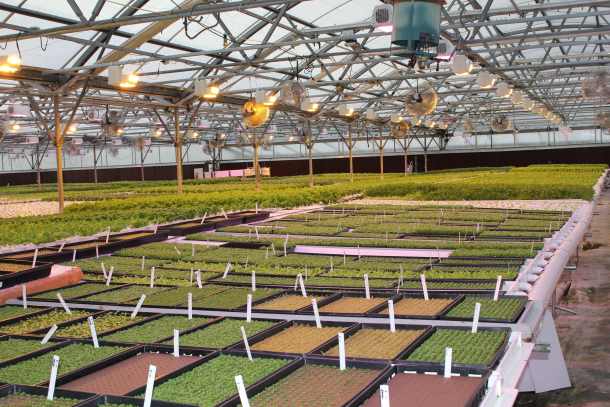
[T]he founders of a small produce operation in Waitsfield are working seven days a weeks to keep up with demand after the company doubled its shipments to Whole Foods in October.
Green Mountain Harvest Hydroponic started shipping watercress to the Whole Foods warehouse in Hartford, Connecticut, once a week about two months ago. At the end of October, they increased their shipments to twice a week, raising their revenue from that one customer from about $9,000 a week to $18,000 a week.
The company has doubled its greenhouse space over the past year and now has half an acre of basil, watercress and lettuce growing under plastic, and 12 full- and part-time employees.
“Lately, just to make it work, we’ve been working seven days a week, 10 hours a day,” said co-founder John Farr.
They expect to be producing $1.5 million worth of produce annually by the end of next year.
“We’re delivering 500 cases a week down there,” said Dave Hartshorn. “It’s huge, and it happened so fast.”
Green Mountain Harvest Hydroponic got its start after Farr met Dave Hartshorn in 2006 at the bar that Farr owned in Waterbury. The two men, both former farmers, became friends, and started talking about hydroponics, a longtime interest for both. They did research, including a visit to a hydroponics operation in Pennsylvania to learn more about the business. In early 2012, they secured a loan for $435,000 from the Vermont Economic Development Authority and acquired the equipment for their greenhouses from a flower farmer near Denver. They harvested their first crop in 2013.
The two learned by trial and error, experimenting with arugula, kale, cilantro, and several herbs, but found that basil, watercress and a summercrisp greenhouse lettuce flourished under LED lights in the year-round growing conditions of the greenhouse.
“We’re farmers,” said Hartshorn, who was raised on a dairy farm in Waitsfield and grew produce for a farmstand as a kid. “You read magazines, you talk to greenhouse growers; there’s a lot of things in farming you wouldn’t know about unless you’re curious and read things and watch videos.”
Hydroponic farming isn’t new; it’s been around for centuries. But it’s not widespread. The initial financial outlay is huge, and some farmers prefer tilling the soil, said Vern Grubinger, vegetable and berry specialist with the University of Vermont Extension. Hydroponic farming requires a great degree of precision, he said.
“The soil buffers a lot of things that you have to control very carefully when you grow in water,” he said. “You better make sure the plants have exactly what they need, or they will not grow well.”
Hartshorn and John Farr said they like hydroponic farming because it doesn’t require heavy equipment, and it removes hazards such as hailstorms, floods, compaction and erosion. It also has its own set of problems with pathogens, insects and mildew, some that it shares with conventional agriculture, and some that are particular to growing in water.
“You can’t be lax around here, because it’ll take you over in a hurry,” Hartshorn said. “You can’t spray when you feel like it. It won’t take long before you’re looking at total crop failure.”
Green Mountain Harvest grows plants in a system of tightly spaced PVC channels, producing 40 times as much as they could conventionally, Farr said.
In a hydroponic greenhouse, “a wheelbarrow of fertilizer will produce a tremendous amount of return because there’s a little trickle of water that goes through the roots carrying its food all the time, it never stops, so when the plant wants it, it’s always there,” Hartshorn said.
There are at least three commercial hydroponic vegetable growers in Vermont, according to the state Agency of Agriculture, Food and Markets. The startup costs are high; the company owes $1.5 million on the greenhouse, solar farm and biomass heating system.
Grubinger estimated there are thousands of greenhouses in Vermont now, where 30 years ago there were just a few hundred.
“Dave’s operation is just kind of taking it to another level,” he said.
Originally, the founders decided to heat the greenhouse with wood chips from the Farr family tree business. They installed a wood-burning furnace from Portugal, but propane prices are so low now that the company hasn’t yet switched to wood. They keep the greenhouse between 68 and 72 degrees, and Farr estimated they used about $30,000 worth of propane last year.
They also have a 100 KW solar system that produces about 50 percent of the company’s electric needs.
Green Mountain Harvest started out with deliveries to local grocers and farmstands and ran into a lot of questions about how their supply would hold up.
“A lot of people I don’t think really trusted the fact we could grow year-round,” John Farr said. “It was a new concept.” But they gradually instilled confidence in local stores and expanded their reach to Boston.
Their big break with Whole Foods came at a food show in Massachusetts in 2014 when Hartshorn and his partner Amy Todisco met a buyer who invited them to bring some lettuce to the chain’s Hingham store. Within about a year and a half, they were driving lettuce to 25 stores in New England, Hartshorn said. Meanwhile, they had picked up customers like City Market and Healthy Living in Burlington and Hannaford Supermarkets. And now they’re looking to sell produce with the Shaw’s grocery chain.
While Farr and Hartshorn are considering construction of another greenhouse, they don’t have ambitions to develop a huge company.
“If I was 20 years younger, I’d probably go for it,” said John Farr, 62, whose brother Ted Farr, 60, is also a company owner. “We’d like to someday sell it to somebody younger who’d like to take it to a higher level.”

Correction: The wattage of the business’ solar system has been corrected.

